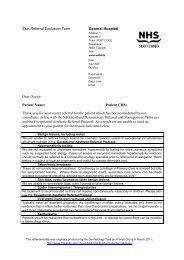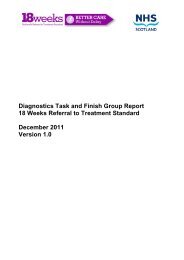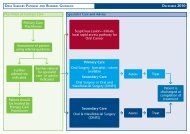Delivering the 18 Weeks Referral to Treatment Standard Output Report
Delivering the 18 Weeks Referral to Treatment Standard Output Report
Delivering the 18 Weeks Referral to Treatment Standard Output Report
You also want an ePaper? Increase the reach of your titles
YUMPU automatically turns print PDFs into web optimized ePapers that Google loves.
during a return outpatient appointment. This is <strong>to</strong> be encouraged, but in manyinstances, current reporting systems mean that <strong>the</strong>se treatments are not recorded aspart of <strong>the</strong> activity. Similarly currently <strong>the</strong>y do not always ‘s<strong>to</strong>p a clock’ as part ofmeasuring patient waiting times.One of <strong>the</strong> key challenges <strong>to</strong> <strong>the</strong>se specialties <strong>the</strong>refore, is capturing and measuring,and <strong>the</strong>n delivering all elements of <strong>the</strong> patient journey. This should facilitate anunderstanding and management of <strong>the</strong> true stage of treatment waiting times in order<strong>to</strong> make progressive improvements <strong>to</strong> reducing waiting times.By reducing <strong>the</strong> component parts of <strong>the</strong> patient journey (i.e. outpatients, inpatients,daycases), achievement of <strong>the</strong> whole pathway, from receipt of referral <strong>to</strong> <strong>the</strong> start ofdefinitive treatment, within <strong>18</strong> weeks becomes more manageable. It is this deliveryrequirement that <strong>the</strong> Task and Finish Group has focused upon, across all <strong>the</strong>specialties, and continue <strong>to</strong> address <strong>the</strong> identified risks <strong>to</strong> delivery and <strong>the</strong>consequent challenges and opportunities as a core part of its outputs.Identified Risks <strong>to</strong> DeliveryFrom its inception, <strong>the</strong> Task and Finish Group highlighted a range of challenges forearly consideration:1. Long waiting times in some dental specialties.2. Interface between primary and secondary care and <strong>the</strong> financial drivers that canaffect this.3. Variations in referral practices and differing treatment pathways across <strong>the</strong> caresettings for a single condition (e.g. simple extraction of <strong>to</strong>oth).4. Variations in referral thresholds, especially for orthodontic treatments.5. Establishment of robust data collection and reporting systems <strong>to</strong> proactivelymanage dental specialties and associated waiting times.6. Uniform application of <strong>the</strong> definitions <strong>to</strong> ensure consistent and accurate recordingof patient journey times.7. Hidden waits for treatments undertaken in <strong>the</strong> outpatient setting which were notpreviously measured.8. Workforce considerations and fur<strong>the</strong>r use of enhanced practitioner roles.9. Organisational profile and integration of dental specialties in<strong>to</strong> waiting timesmanagement processes.Priority Task and Finish Group Improvement ActionsAs part of <strong>the</strong> methodology for minimising <strong>the</strong>se risks, <strong>the</strong> Dental Specialties Taskand Finish Group identified <strong>the</strong> following priority actions for <strong>the</strong> Group:Dental Specialties Task & Finish Group – January 2011 11






![Dr Matthew Checketts, NHS Tayside [PDF - 6Mb] - 18 Weeks](https://img.yumpu.com/49027155/1/190x143/dr-matthew-checketts-nhs-tayside-pdf-6mb-18-weeks.jpg?quality=85)









![Mark Sindall, NHS Dumfries and Galloway [PDF - 227Kb] - 18 Weeks](https://img.yumpu.com/30080335/1/190x143/mark-sindall-nhs-dumfries-and-galloway-pdf-227kb-18-weeks.jpg?quality=85)